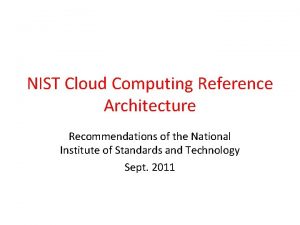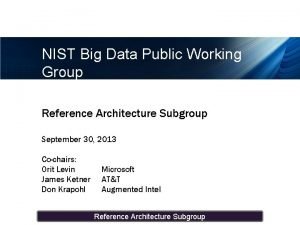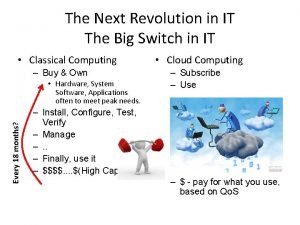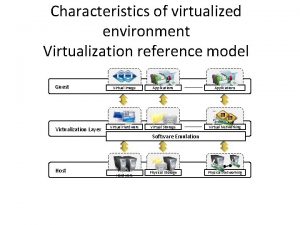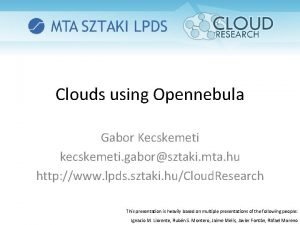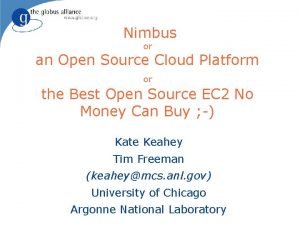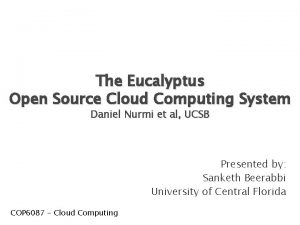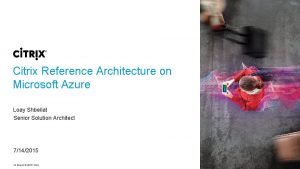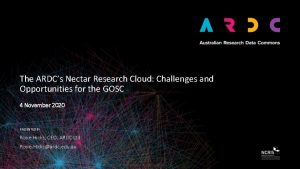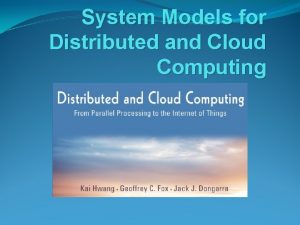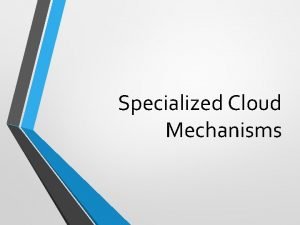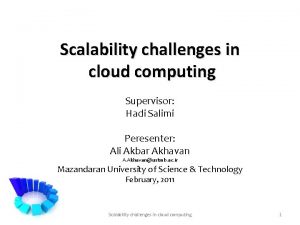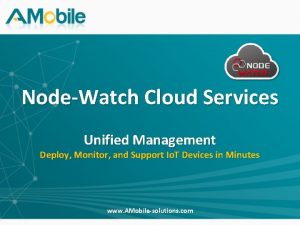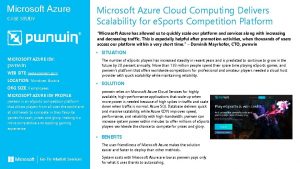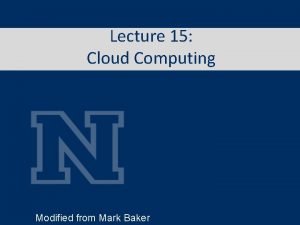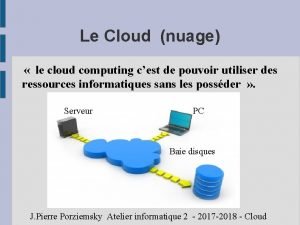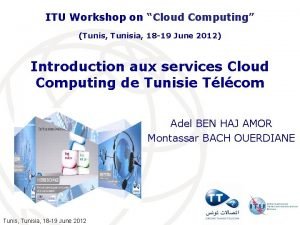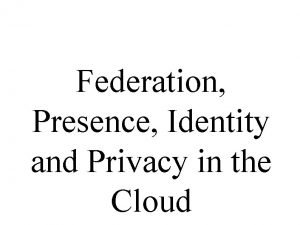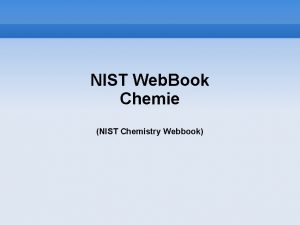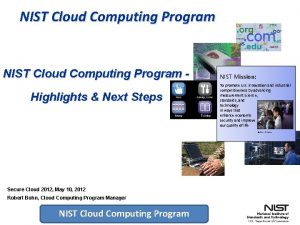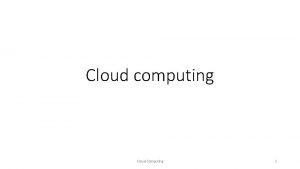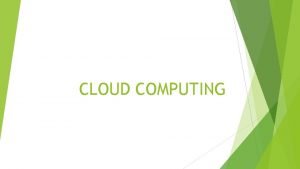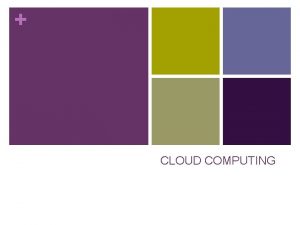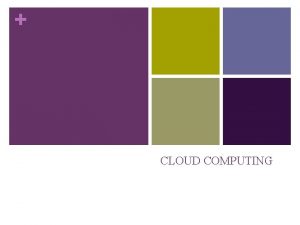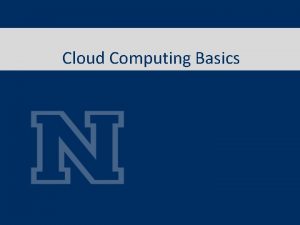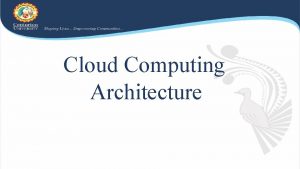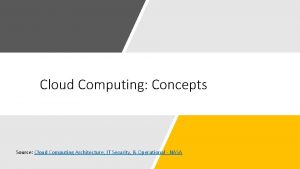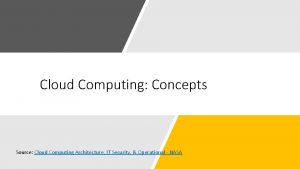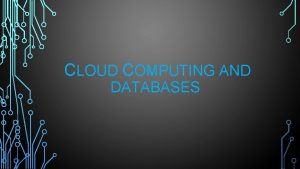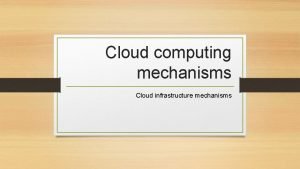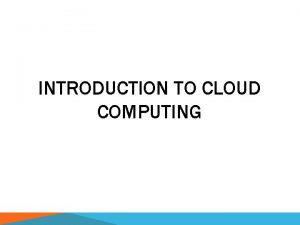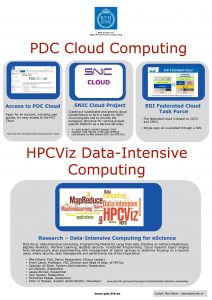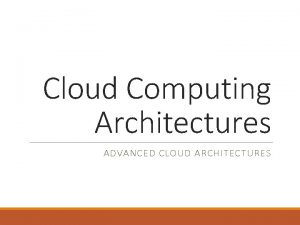NIST Cloud Computing Reference Architecture Recommendations of the
































- Slides: 32

NIST Cloud Computing Reference Architecture Recommendations of the National Institute of Standards and Technology Sept. 2011

Reference Architecture • A template description of the architecture, probably defined at different levels of abstraction – Highly abstract showing different functionalities – Lower level showing methods performing specific task • Vendor-neutral description that does not stifle innovation by definition a specific technical solution • A conceptual model for discussing the technical requirements and operations of cloud computing • A blueprint to guide developers in the design of (cloud) services and applications – Blueprint: compositions of interconnected services implementing reusable logic for building applications), list of functions and their interfaces (APIs), descriptions of their interactions 10/31/2020 NIST Reference Architecture 2

Service Deployment • A cloud infrastructure may be operated as public, private, community of hybrid cloud – Public: same infrastructure used by many users over the public network – Private: exclusive access to specific end-user, hosted on user’s premises (on-site installations) or by hosting company – Community: access to groups of users with similar concerns – Hybrid: combined offering (e. g. , private/public) • The differences are based on how exclusive the computing resources are made to a Cloud Consumer 10/31/2020 NIST Reference Architecture 3

Parts of The discussion • Actors and roles: core individuals or users with key responsibilities in system function • Architectural components for managing and providing cloud services for – Deployment – Orchestration – Management – Security – Privacy 10/31/2020 NIST Reference Architecture 4

Actors and Roles • Individuals or organizations with key roles – Consumer: acquires and uses services – Provider: the purveyor of services – Broker: intermediate between consumer – provider, they hide complexity of services or create new services – Auditor: independent performance, security monitoring and assessment of cloud services – Carrier: provides connectivity and transport of data and services between providers and consumers 10/31/2020 NIST Reference Architecture 5

Conceptual Reference Model 10/31/2020 NIST Reference Architecture 6

Cloud Consumer • • Browses the service catalogue of the provider Requests services depending on activities, usage scenarios Sets up service contracts with the provides May be billed for the service – Saa. S consumers may be billed based on number of users, time of use, net bandwidth, storage volume – Iaa. S, Paa. S consumers may be billed according to processing, storage, network resources, number of VMs, http calls, number of IPs used, net bandwidth, storage volume • Consumers need SLAs to specify their performance requirements to be fulfilled by the provider (however SLAs are offered by cloud producers and in most cases aren't negotiable) 10/31/2020 NIST Reference Architecture 7

Service Level Agreements (SLAs) • Contracts that are negotiated and agreed between provider and customers so to locate/reserve resources to satisfy consumers’ requirements with efficiency and optimally resource and service usage • To guarantee an agreed SLA, the auditor must be capable of measuring and monitoring relevant metrics (e. g. , service availability, network metrics, storage metrics) • Different SLA models must be considered for Iaa. S, Paa. S and Saa. S as each model sets different requirements – SLAs can be defined clearly for Iaa. S; – for Paa. S and Saa. S SLAs are still vague and difficult to be defined as these refer to higher levels of functionality but, can be agreed between providers / customers based on application requirements (business case) and business level plan 10/31/2020 NIST Reference Architecture 8

SLAs for Iaa. S 10/31/2020 NIST Reference Architecture 9

Examples of Cloud Services 10/31/2020 NIST Reference Architecture 10

Cloud Provider • Acquires and manages the computing infrastructure • Runs the cloud software, makes services available to interested parties • Makes arrangements / contracts with consumers • May also list SLAs i. e. Promises to consumers or limitations and obligations that consumers must accept • Provider’s pricing policy and SLAs are not negotiable in most cases 10/31/2020 NIST Reference Architecture 11

Responsibilities of Cloud Provider 10/31/2020 NIST Reference Architecture 12

Scope of Control (Provider) • Application layer: end-user apps and services used by Saa. S consumers, installed/managed by Paa. S consumers and Saa. S providers • Middleware layer (VM layer): provides building blocks for app development (libraries, dbms, Java VMs), used by Paa. S consumers, installed/maintained/managed by Paa. S providers, hidden from Saa. S consumers • OS layer: operating system VMs and drivers, hidden from Saa. S /Paa. S consumers, controlled by Iaa. S providers, used by Iaa. S consumers. An Iaa. S provider may allow multipe OS’s as VMs 10/31/2020 NIST Reference Architecture 13

Scope of Control • Saa. S: Consumers have only limited administrative control of the applications and services • Paa. S: The provider manages infrastructure and provides tools of deployment of applications; the consumer has control over the application but limited / no access to the infrastructure (e. g. OS, servers, storage, drivers) • Iaa. S: The provider acquires physical resources (servers, network, storage) and runs the software to make these available to Iaa. S, Paa. S consumers through VMs; consumers have control over virtual software components (OS, network) 10/31/2020 NIST Reference Architecture 14

Scope of Control • Provider and consumer share the control of resources in a cloud 10/31/2020 NIST Reference Architecture 15

Cloud Auditor • Performs independent examination of cloud service controls and express opinion / issues evaluation – Ideally, have a contractual clause enabling 3 rd parties to assess cloud operations – To determine the extend to which cloud operations are implemented/executed as planned and agreed • Auditors objective is to verify conformance to standards (e. g. OCCI) or to security, privacy controls, performance, conformance to SLAs etc. – Issue security, privacy, performance audits 10/31/2020 NIST Reference Architecture 16

Cloud Broker • Integration of cloud services by consumers can be too complex and can be requested from a cloud broker rather than from a provider directly – An entity/service operated by the provider or third party • Provides services in three forms – Intermediation: presents the service to consumers (e. g. In catalogue), provides/enhances/improves a given service (e. g. by adding identity management, performance reporting, enhanced security) – Aggregation: combines and integrates multiple services into one – Arbitrage: the services being aggregated may change or come from different providers 10/31/2020 NIST Reference Architecture 17

Example Usage Scenario for Broker • A consumer requests a service from a broker instead of contacting the provider directly • The broker creates a new service by combining multiple services 10/31/2020 NIST Reference Architecture 18

Interactions between Actors 10/31/2020 NIST Reference Architecture 19

Cloud Carrier • Acts as an intermediary that provides connectivity and transport of cloud services between cloud consumers and cloud providers • Provides access to consumers through a public/private network or telecom provider • A provider may set-up SLAs with cloud carriers in order to provide services with the level of SLAs offered to consumers (e. g. may require dedicated or secure connections) 10/31/2020 NIST Reference Architecture 20

Architectural Components • Architectural Components for managing and providing cloud services, describe the important aspects of – Service deployment, orchestration, management, security and privacy – Portability and interoperability issues for data and services are also crucial factors as consumers need confidence and moving data and services across clouds – Security and privacy build trust and acceptance in clouds ability to provide a trustworthy and reliable system – Business support: implementation of specific business model 10/31/2020 NIST Reference Architecture 21

Conceptual Reference Model 10/31/2020 NIST Reference Architecture 22

Service Orchestration • Composition of service components to support cloud providers activities (in coordination with management of resources) in order to provide cloud services • Service Layer: interfaces for accessing services (typically for Iaa. S, Paa. S, Saa. S) • Resource Abstraction / Control Layer: interfaces for accessing virtualized resources e. g. hypervisors, VMs, virtual storage • Physical Resource Layer: interfaces for accessing to physical resources (computers, disks, routers, firewalls, etc. ) 10/31/2020 NIST Reference Architecture 23

Service Management • Includes all of service-related functions that are necessary for the management and operation of services available to consumers • Can be described from different perspectives – Business support – Provisioning and configuration – Portability and interoperability 10/31/2020 NIST Reference Architecture 24

Cloud Service Management 10/31/2020 NIST Reference Architecture 25

Management: Business Support • Business related services – Customer management: manage customer accounts, open/close accounts, manage user profiles, manage provider-customer relationships – Contract management: setup/negotiate/terminated contract and SLAs – Pricing/Rating: evaluate cloud services, handle promotions and pricing rules by user profile – Accounting and Billing: collect billing information, send billing statements, manage payments – Reporting/auditing: monitor user operations, generate reports 10/31/2020 NIST Reference Architecture 26

Management: Provisioning/Configuration • Responsibilities included – Rapid provisioning: automatically deploy cloud services based on user demands – Resource changing: adjust service configurations or, resource assignment for repairs/upgrades – Metering: Provide metering capability per service type – SLA management: define SLAs, monitor SLAs, enforce SLAs 10/31/2020 NIST Reference Architecture 27

Management: Portability/Interoperability • Cloud adoption depends also how the cloud can address security, privacy, portability and interoperability concerns • Portability: ability to move applications and data across clouds and cloud providers – Data portability: copy/move objects across clouds – System portability: move / migrate a stopped VMs or applications with their contents – Service Interoperability: use data and services across multiple cloud providers using common interface (RESTful APIs) • Different requirements for different service models: Iaa. S, Saa. S focus on data portability, Iaa. S, Paa. S on compatibilities between different virtualization technologies, Paa. S focus also on service interoperability 10/31/2020 NIST Reference Architecture 28

Privacy • Ensure privacy of collected personal identifiable information that can be used to distinguish, trace user’s identity based on – user habits (e. g. Buying patterns) – personal data: user id’s, financial, health data, usage data – Also related to data security as application data encompass user related information • Mainly a responsibility of cloud providers 10/31/2020 NIST Reference Architecture 29

Security • Cloud systems need to address security requirements such as authentication, authorization, confidentiality, identity management, security monitoring, security policy management, incident response • Responsibility shared between provider and consumer • Consider impacts per service model: – Saa. S: manage accessibility of cloud offerings using network connection and through Web browser (Web browser security is an issue) – Iaa. S: hypervisor security for VM isolation – Paa. S: user authorization to use services • Impacts per deployment model: private cloud is dedicated to one customer, public is not 10/31/2020 NIST Reference Architecture 30

Open. Fog Architecture Overview Open. Fog Consortium Architecture Working Group Feb 2016

References • NIST Cloud Computing Reference Architecture: Recommendations of the National Institute of Standards and Technology http: //disa. mil/Services/Do. D-Cloud. Broker/~/media/Files/DISA/Services/Cloud-Broker/nist -cloud-ref-architecture. pdf • Open. Fog Architecture Overview, Open. Fog Consortium Architecture Working Group, 2016 http: //www. openfogconsortium. org/ • Practical Guide to SLAs , v 2, 2015 http: //www. cloudcouncil. org/CSCC-PG-to-Cloud-Service-Agreements. Webinar-Presentation-061115. pdf 10/31/2020 NIST Reference Architecture 32
 What is cloud computing reference architecture
What is cloud computing reference architecture Nist big data reference architecture
Nist big data reference architecture Cloud computing reference model
Cloud computing reference model Virtualization environment
Virtualization environment Cloud computing refers to
Cloud computing refers to Opennebula architecture
Opennebula architecture Nimbus cloud computing
Nimbus cloud computing Globus toolkit architecture in cloud computing
Globus toolkit architecture in cloud computing Eucalyptus open source
Eucalyptus open source Green cloud computing architecture
Green cloud computing architecture Citrix on azure architecture
Citrix on azure architecture Conventional computing and intelligent computing
Conventional computing and intelligent computing Reference node and non reference node
Reference node and non reference node Reference node and non reference node
Reference node and non reference node Vodafone business hosting
Vodafone business hosting Virtualization techniques in cloud computing
Virtualization techniques in cloud computing Tools and mechanisms of virtualization
Tools and mechanisms of virtualization A type of cloud
A type of cloud Ardc nectar
Ardc nectar All resources are tightly coupled in computing paradigm of
All resources are tightly coupled in computing paradigm of Multi device broker in cloud computing
Multi device broker in cloud computing Seminar on green computing
Seminar on green computing Scalability issues in cloud computing
Scalability issues in cloud computing Cloud conclusion
Cloud conclusion Cloud unified management
Cloud unified management Cloud computing cambridge
Cloud computing cambridge Case study on microsoft azure in cloud computing
Case study on microsoft azure in cloud computing Cloud computing layers
Cloud computing layers Regarder introduction to cloud computing
Regarder introduction to cloud computing Sejarah cloud computing
Sejarah cloud computing Cloud-first headless cms
Cloud-first headless cms Cloud computing tunisie
Cloud computing tunisie Permissive federation
Permissive federation
